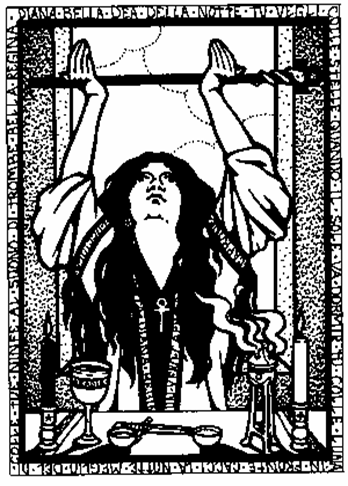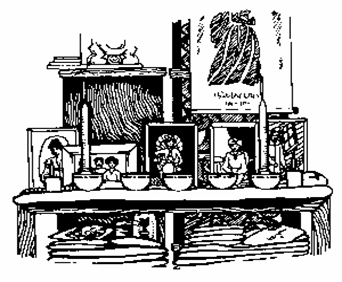LESSON IV
THE ALTAR
Own the complete set today. Witchschool Store
The main purpose of an altar is to provide focus.
It can be used to focus on the Divine Powers -this is worship.
It can be used to focus energy for making changes in our lives -this is magic.
It can be used to focus on communication with our Higher Selves and SPIRIT GUIDES -this is meditation.
All of these -worship, magic, meditation -are ways of focusing our psychic energy to accomplish specific ends. The altar can aid in that focus, and can be used to augment that energy and enhance the result.
Because so much of this process depends on the energy of YOU, your altar should be so designed as to have meaning for YOU and to provoke an emotional and spiritual reaction from you. This is particularly important because no matter how beautiful or “correct” your altar is, it won’t matter to you if it doesn’t help you access your own inner energies.
Altars have many variations. The simplest altar need be no more than a picture on the wall or a clear space on a table. The most elaborate altars are masterpieces of exquisite art. Most altars are somewhere in between.
In this lesson you will learn how to construct a basic altar, which you can then adapt to your personal needs -at which you can do magic, work ritual, and commune with the Powers That Be.

GEOMANCY
Your first consideration is where to put your altar.
Most people put their altar in their bedroom. This makes it a very personal space, and assures privacy. This is especially good if you live in a home with non-Pagan roommates or family who might be intimidated by a holy object such as an altar in the living room.
If however your home is wholly Pagan, you may wish a more public altar in a living room, or a special temple room, at which your whole family can worship.
If you do this, you will probably still want a personal altar in your bedroom to use privately, which is attuned solely to your own energies.
In this way you can enjoy with your family the best aspects of both personal and communal religious devotion.
Once you’ve decided what room to put your altar in, you must decide where in the room to put it.
For many this is an easy decision -if you have only three feet of open wall space in your room and no way to rearrange it otherwise, obviously the altar will go in that three feet.
But if you have more than one choice available to you, you will wish to consult the principles of GEOMANCY.
Geomancy is the art of reading the Earth’s energies and aligning ourselves and our works to them -and through them to the energies of the Universe as well.
Geomancy is an ancient art in all parts of the world. Different peoples have developed different ideas about it, depending on the needs of their differing cultures. In Asia it is called FENG SHUI, and this form of Geomancy has become quite popular lately.
The idea of Geomancy like so many other things in magic comes from the ancient maxim of Hermes Trismagistus: “As Above, So Below.” That is to say, the idea that the essential nature of the Universe will be reflected in all of Her parts, no matter how great or small.
The main principles of western Geomancy are exemplified by the Magic Circle. Briefly, the direction of East is creativity and new beginnings. South is action and manifestation. West is emotion and the subconscious. North is wisdom. Everything that is Above or goes to the right (DEOSIL) is connected to the
God, to matter, and to physical manifestation. Everything that is Below or that goes to the left (TUATHAIL, or less correctly “Widdershins”) is connected to the Goddess, to spirit, and to cleansing. You will learn more about this in LESSON V.
Your altar may be aligned to any direction whose qualities you desire to draw upon, but it is traditional -and generally best for the beginner- to place the altar toward the North. North is the Direction of wisdom and understanding, where the qualities of the other directions are integrated and learned from. Placing the altar in the North will help you to align yourself to wisdom and integration, and help you to bring these qualities to your magical and meditative practice.
Your altar itself also has a geomancy to consider.
The right side of the altar is warm. It is associated with the God, the Sun, Day, physical energy, and the elements of Air and Fire.
The left side of the altar is cool. It is associated with the Goddess, the Moon and Stars, spiritual energy and magic, and with the elements of Water and Earth.
The middle of the altar is associated with Spirit, or Primeval Deity, Who is within both Goddess and God, as well as all other things.
The back part of this middle area is associated with Primeval Deity, that aspect of the Goddess that existed before the creation of the God, and might be described as the Higher Self of the Universe. Hear is the Divine plan, the blueprint of the Universe which is mirrored in every aspect of creation. This is the soul of Deity, which is expressed in many different faces. This is often the focal point of the altar, where Deity is honored in whatever form is being invoked at the time.
The front part of the middle space represents spiritual energy manifesting in the physical world -the union of Goddess and God in the ongoing process of creation. This is where your magical working will be done. This area is normally left empty when work is not being done.
Altar once belonging to Rev. Don Lewis. Note use of wooden bookcase as altar table.
(Artwork reprinted from the Wheel of Hekate no. 3, Samhain ‘87)
CREATING YOUR ALTAR
Before you set up your altar, you will want to purify and bless your altar space.
Magic is the focusing of spiritual energy, and spiritual energy is constantly being affected by the actions and emotions of people. Consequently it needs to be purified or cleansed -to have the residues of emotions and actions removed, so that energy can be refocused and re-directed. You will remember that this spiritual energy, which comes from the Goddess, suffuses all people and things and is the basis of existence; it is directed and shaped by concentrated thought, emotion, and physical action.
Once you have cleansed the energy you may proceed to assemble your altar. This is best done immediately after the cleansing, and you should have all the necessary pieces nearby before hand.
You will find a basic space cleansing ritual in the SPELL OF THE MONTH section of this lesson, which you may use to prepare your altar space to receive your altar.
ALTAR TABLE
The ALTAR TABLE is the surface upon which your altar is set up. It is not necessarily a table as such, but can be any of a wide variety of surfaces.
Traditionally altars have often been erected out-of-doors. They still are at ritual gatherings and for certain observances. In this circumstance the altar is often placed directly on the ground or upon a log or boulder. This is the ideal, connecting directly with Mother Earth and through Her the Universe.
In this same spirit your indoor altar table is best made of wood or stone (as marble, for instance). Metal is not considered desirable, for the horizontal surface at least -though the altar table may stand on metal legs and often includes metal components.
Most commonly an ordinary piece of household furniture is used for the altar table, to conserve space. Many people set up their altars on their bedroom dresser top, or on a nightstand. Some people use the top shelf of a bookcase, showing reverence for knowledge.
Some people, to maintain an even closer link with Earth, will place a bowl or box lined with soil on their altar table and assemble their altar in this -though this is an unusual practice. More commonly a jar or bowl of Earth will be kept ON the altar for the same reason, rather than being used AS the altar.
ALTAR CLOTH
You may want to use an ALTAR CLOTH. This is an ancient tradition arising from the time when all cloth was hand-woven and precious, and any type of embroidery a luxury.
Today altar cloths are used because of their beauty and capacity for symbolism. Details of color and decoration can greatly influence the flavor and energy of the altar. If you wish to use an altar cloth you will want to consider these details when choosing it.
If you are able, decorate the altar cloth yourself, with embroidery or fabric paint, using symbols that have relevance to your personal philosophy and relationship with Deity. This will bond it to you and fill it with your energy. Concentrate on positive, self-empowering thoughts as you work, so that the cloth will be imbued with these and radiate them back to you during ritual and magical working.
If you prefer a less handmade altar cloth for any reason, choose a cloth that resonates strongly with you. An heirloom, a treasured gift, or a cloth that puts you in mind of your hopes and dreams.
To prepare the altar cloth for the altar, you will want to consecrate it. Do this by holding the cloth in your hands. Say “I send out from this cloth any negativity which may lie within it” or words to that effect, and visualize the cloth flooded with a strong yellow light, which passes through it carrying out all impurities. Then say something like “I do bless and consecrate this cloth to my altar that it may aid me in my workings and my growth” and visualize a clear blue-white light coming down from above and filling the cloth until it glows with white light like the Moon. Use this same basic technique to consecrate the altar pieces described below as well.